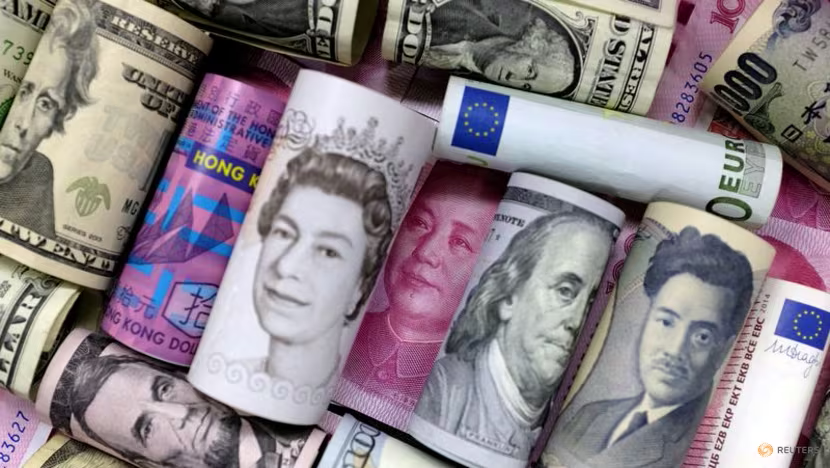
BIX ARTICLE
World's Biggest Bond Markets Steady After Heavy Selloff
Oct 05, 2023
|
5 min read
Featured Posts
Social Bonds Illustrative Use-Of-Proceeds Case Studies Coronavirus
Jul 06, 2020
|
2 min read
Sustainable Banking Network (SBN) Creating Green Bond Markets
Jul 06, 2020
|
2 min read
Why is Inflation Making a Big Comeback After Being Absent for Decades in the U.S.?
Mar 24, 2022
|
7 min read
SC issues Corporate Governance Strategic Priorities 2021-2023
Mar 29, 2022
|
3 min read

FILE PHOTO: Euro, Hong Kong dollar, U.S. dollar, Japanese yen, pound and Chinese 100 yuan banknotes are seen in this picture illustration, January 21, 2016. REUTERS/Jason Lee/Illustration/File Photo
The tone was calmer later on Wednesday as bond yields, which move inversely to prices, retreated. But with resilient US economic data, a sharp unwinding of traders' positions for a bond rally and rising bond supply, the growing sense that interest rates in major economies will stay higher for longer to contain inflation has hit home.
In the US Treasury market - considered the bedrock of the global financial system - 10-year yields have jumped as much as 20 basis points (bps) to 4.8 per cent this week alone. They are up almost 100 bps this year, having jumped over 200 bps in 2022.
Many asset managers who had held bonds expecting prices to rally are now throwing in the towel.
"Right now there is huge momentum behind the sell off (in Treasuries) because the positioning in the market has been wrong," said Juan Valenzuela, fixed income portfolio manager at asset manager Artemis.
"A lot of people bought into the idea that because the Federal Reserve was reaching the peak of rate hikes, it was time to buy government bonds."
Thirty-year US yields on Wednesday touched the 5 per cent level for the first time since the global financial crisis and, as the rout spread, Germany's 10-year Bund yield hit 3 per cent, a fresh milestone in a market where yields were negative in early 2022.
US. 30-year yields later retreated and were recently at 4.87 per cent, after the ADP National Employment Report showed US private payrolls increased far less than expected in September.
Australian and Canadian 10-year bond yields have surged over 20 bps each this week, and British 30-year government bond yields hit a fresh 25-year high above 5 per cent on Wednesday before declining to 4.993 per cent.
In a further sign of investor nervousness, the closely-watched MOVE bond volatility index is at a four-month high.
Also weighing on prices is an increase in the supply of bonds, as governments sell more debt to fund budget deficits while offloading the vast bond holdings they built up through recent crises.
"The sell off is mostly technical, driven by bigger supply due to deficits and less demand," said Pablo Calderini, chief investment officer at Graham Capital Management.
Concerns over US political governance are another factor. A handful of Republicans in the US House of Representatives on Tuesday ousted Republican Speaker Kevin McCarthy, just days after Congress narrowly averted a government shutdown.
The recent weakness in Treasuries "suggests that a political uncertainty risk premium is being built in again," said Michael Metcalfe, head of global macro strategy at State Street Global Markets in London.
RIPPLES
Government borrowing costs influence everything from mortgage rates for homeowners to loan rates for companies.
The speed of the bond rout sparked alarm across equity markets and drove the safe-haven dollar to its highest in months against the euro, pound and embattled Japanese yen.
World stocks hit their lowest since April on Wednesday, and the cost of insuring exposure to a basket of European corporate junk bonds hit a five-month high, according to data from S&P Global Market Intelligence.. The pullback in yields later on Wednesday, however, gave some respite to US stocks, with the S&P 500 last up 0.49 per cent.
"We are very cautious on risky assets at this juncture," said Vikram Aggarwal, sovereign bond fund manager at Jupiter.
He said riskier assets like equities and corporate credit were vulnerable to an eventual recession caused by central bank rate hikes. Or, "we get a higher for longer scenario where (interest) rates stay where they are... that's ultimately pretty negative for risky assets too.”
A fresh surge in borrowing costs is a headache for central banks, as they weigh up the need to keep rates high to contain inflation against a deteriorating economic outlook.
However, uncertainty about when and in what form that deterioration occurs is driving further complications in bond markets, and contributing to the sharper sell off in longer dated bonds.
The 10-year US term premium, a closely-watched measure of the compensation investors demand to lend money for the longer term, has turned positive for the first time since June 2021 and risen over 70 basis points since the end of August, according to the New York Fed.
"Everybody's been calling for a recession that just simply refuses to arrive. And then you've got the march higher in oil prices, which of course is complicating the picture in terms of the outlook for policy rates," said Rabobank head of rates strategy Richard McGuire.
"All of that, I think is conspiring to see investors very wary of locking up their money in longer dated government bonds. They're demanding compensation for that," McGuire said.
Disclaimer
The information provided in this report is of a general nature and has been prepared for information purposes only. It is not intended to constitute research or as advice for any investor. The information in this report is not and should not be construed or considered as an offer, recommendation or solicitation for investments. Investors are advised to make their own independent evaluation of the information contained in this report, consider their own individual investment objectives, financial situation and particular needs and should seek appropriate personalised financial advice from a qualified professional to suit individual circumstances and risk profile.
The information contained in this report is prepared from data believed to be correct and reliable at the time of issuance of this report. While every effort is made to ensure the information is up-to-date and correct, Bond and Sukuk Information Platform Sdn Bhd (“the Company”) does not make any guarantee, representation or warranty, express or implied, as to the adequacy, accuracy, completeness, reliability or fairness of any such information contained in this report and accordingly, neither the Company nor any of its affiliates nor its related persons shall not be liable in any manner whatsoever for any consequences (including but not limited to any direct, indirect or consequential losses, loss of profits and damages) of any reliance thereon or usage thereof.
YOU MAY ALSO LIKE
ARTICLE
Oct 05, 2023
|
5 min read
ARTICLE
Jan 08, 2019
|
6 min read
ARTICLE
Jul 02, 2018
|
6 min read
ARTICLE
May 16, 2018
|
4 min read


